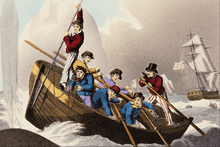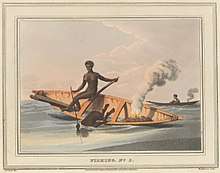John Heaviside Clark
John Heaviside Clark (c.1771–1863) was a Scottish aquatint engraver and painter of seascapes and landscapes. He was also known as Waterloo Clark, because of the sketches he made on the field directly after the Battle of Waterloo.[1]

A ship's boat attacking a whale, hand-colored engraving from 1813

Fishing No. 1, drawing by Clark engraved in aquatint by Matthew Dubourg, 1813
Clark exhibited regularly at the Royal Academy between 1801 and 1832. He was the author of A practical essay on the art of Colouring and Painting Landscapes, with illustrations, published in 1807, and A practical Illustration of Gilpin's Day,[1] with thirty colour plates, based on monochrome studies representing different times of day by William Gilpin, in 1824.[2]
He died in Edinburgh in 1863.[1]
References
- Bryan 1886
- "John Heaviside Clark (ca. 1770–1836) Lightning". The Morgan Museum. Retrieved 5 July 2012.
Sources

This article is issued from Wikipedia. The text is licensed under Creative Commons - Attribution - Sharealike. Additional terms may apply for the media files.